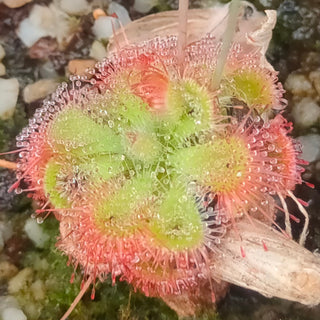Trichocereus macrogonus
SAN PEDRO CACTUS
- Unit price
- / per
Trichocereus macrogonus, synonym Echinopsis macrogonus, is a species of cactus found in Ecuador, Peru and Bolivia. Plants contain varying amounts of the psychoactive alkaloid mescaline. They have been used both ritually and in traditional medicine from pre-Columbian times. Trichocereus macrogonus is one of a number of similar species that may be called San Pedro cactus. Indigenous names include achuma and huachuma, although these too may be applied to similar species.
The species has erect stems, 2.5-5 m (8-16 ft) tall, with branches generally with a diameter of 6-15 cm (2-6 in), occasionally more. At the base of the stem there are usually seven or eight ribs. Generally the species has relatively few ribs, typically six to eight, occasionally five or nine. The circular areoles are 6 mm (0.2 in) across, grey or dark brown, with needle-like spines, and are spaced more than 2.5 cm (1.0 in) apart. The number and length of the spines varies. In T. macrogonus var. macrogonus, older areoles may have up to 20, with three or four prominent, longer and more robust central spines up to 5 cm (2.0 in) long. In var. pachanoi, the older areoles may have only three to seven shorter and thinner spines. The spines are darker at the end. The flowers are carried mostly near the top of the stems. In total they may be up to 21 cm (8.3 in) long. The tepals may be pale yellow or yellowish green, rarely pink. The small seeds are broadly ovoid, 0.9-1.1 mm (0.04-0.04 in) long.
Plants of the World Online regards the species as native to Peru, Ecuador, and Bolivia, and introduced to central Chile, Colombia, mainland Spain and the Canary Islands. However, plants are widely cultivated making the true origins of the species difficult to determine. It has been speculated that the original native distribution may only be the high valleys of Peru and perhaps also northwestern Bolivia.
This species of cactus has been used by humans for several millennia. The oldest find was located in the Guitarrero Cave, in Peru. In this cave, inhabited continuously since 8600 BCE, a high concentration of T. macrogonus pollen from the oldest phase of human occupation has been detected, as well as some fragments of cactus, which would testify to the intentional introduction of this plant inside the cave. Ritual uses of the species are depicted on pre-Columbian Peruvian ceramics and other archaeological objects, with one use dated to about 1300 BCE. Indigenous names include achuma and huachuma.
Type: Perennial or house plant
Hardiness zone: 8-10
Height: 10-20', 3-6m
Seeds per packet: 10
Fill small pots with a 50:50 compost and sand mix, and soak the compost using boiling water to kill parasites. Allow to drain and cool for about an hour. Surface sow as light aids germination. Water the seeds in. Cover the pots with plastic, or place in a clear ziplock bag. Place in a well lit window but not in direct sunlight. Temperature 80F (26C) to 110F (43C) during the day, and must dip below 80F at night for best germination results. If seed trays begin to dry out, spray to moisten the surface. Seeds can be slow to germiante, 6 weeks to 10 months.
Ornamental use only. These seeds and/or plants are poisonous.
Trichocereus macrogonus
SAN PEDRO CACTUS
- Unit price
- / per
Multiple secure payment options available.
Adding product to your cart
You may also like
Trichocereus macrogonus, synonym Echinopsis macrogonus, is a species of cactus found in Ecuador, Peru and Bolivia. Plants contain varying amounts of the psychoactive alkaloid mescaline. They have been used both ritually and in traditional medicine from pre-Columbian times. Trichocereus macrogonus is one of a number of similar species that may be called San Pedro cactus. Indigenous names include achuma and huachuma, although these too may be applied to similar species.
The species has erect stems, 2.5-5 m (8-16 ft) tall, with branches generally with a diameter of 6-15 cm (2-6 in), occasionally more. At the base of the stem there are usually seven or eight ribs. Generally the species has relatively few ribs, typically six to eight, occasionally five or nine. The circular areoles are 6 mm (0.2 in) across, grey or dark brown, with needle-like spines, and are spaced more than 2.5 cm (1.0 in) apart. The number and length of the spines varies. In T. macrogonus var. macrogonus, older areoles may have up to 20, with three or four prominent, longer and more robust central spines up to 5 cm (2.0 in) long. In var. pachanoi, the older areoles may have only three to seven shorter and thinner spines. The spines are darker at the end. The flowers are carried mostly near the top of the stems. In total they may be up to 21 cm (8.3 in) long. The tepals may be pale yellow or yellowish green, rarely pink. The small seeds are broadly ovoid, 0.9-1.1 mm (0.04-0.04 in) long.
Plants of the World Online regards the species as native to Peru, Ecuador, and Bolivia, and introduced to central Chile, Colombia, mainland Spain and the Canary Islands. However, plants are widely cultivated making the true origins of the species difficult to determine. It has been speculated that the original native distribution may only be the high valleys of Peru and perhaps also northwestern Bolivia.
This species of cactus has been used by humans for several millennia. The oldest find was located in the Guitarrero Cave, in Peru. In this cave, inhabited continuously since 8600 BCE, a high concentration of T. macrogonus pollen from the oldest phase of human occupation has been detected, as well as some fragments of cactus, which would testify to the intentional introduction of this plant inside the cave. Ritual uses of the species are depicted on pre-Columbian Peruvian ceramics and other archaeological objects, with one use dated to about 1300 BCE. Indigenous names include achuma and huachuma.
Type: Perennial or house plant
Hardiness zone: 8-10
Height: 10-20', 3-6m
Seeds per packet: 10
Fill small pots with a 50:50 compost and sand mix, and soak the compost using boiling water to kill parasites. Allow to drain and cool for about an hour. Surface sow as light aids germination. Water the seeds in. Cover the pots with plastic, or place in a clear ziplock bag. Place in a well lit window but not in direct sunlight. Temperature 80F (26C) to 110F (43C) during the day, and must dip below 80F at night for best germination results. If seed trays begin to dry out, spray to moisten the surface. Seeds can be slow to germiante, 6 weeks to 10 months.
Ornamental use only. These seeds and/or plants are poisonous.
















































